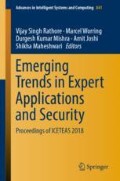Abstract
Silicon solar cell is now accepted as the better energy usage system according to the capital investment but we all know that it is not independently very much efficient. So far, it is simulated with graphene to enhance the output. The paper will show and study the factors like current density, absorption coefficient and wavelength spectrum of sun are studied by relating their characteristics and equation to each other to clear some dependency scenario of solar energy on graphene. Here, the equations are implemented by modulating the Simulink model and therefore, it is synthesized by Finite Difference Method using MATLAB tool, and the resulting graphs are obtained by SIMULINK toolbox through calibrating the parameters. The radiative recombination in GaAs tends to give loss of nearly ∼5% of light generated carrier loss. Because of large optical absorption coefficient of GaAs, calculation of generation rate of carrier charges is done by not including light’s multi-reflection in solar cell.
Masterminded EasyChair and created the first stable version of this document.
Created the first draft of this document.
Access this chapter
Tax calculation will be finalised at checkout
Purchases are for personal use only
References
Song X, Oksanen M, Sillanpää MA, Craighead HG, Parpia JM, Hakonen PJ (2011) Stamp transferred suspended graphene mechanical resonators for radio frequency electrical readout. Low Temperature Laboratory, School of Science, Aalto University, PO Box 15100, FI-00076 Aalto, Finland; Center for Materials Research, Cornell University, Ithaca, New York 14853, USA, vol 12, pp 198–202, 11 Jan 2011
Dikin DA et al (2007) Preparation and characterization of graphene oxide paper. Nature 448:457–460
Novoselov KS et al (2005) Two dimensional gas of massless Dirac fermions in graphen. Nature 438:197–200
Shahicli GG, Warncick I, Ivnri UD, Wu B, Taur Y, Wong C, Chcn CL, Rotlrigucz M, Tang DD, lcnkins KA (1992) High a high performance bicmos techology lisinc; 0.25 pin Cmos and Double Poly Dipolar. In: June 1992, Symposium on VLSI technology digest of technical papers, IEEE confrence, p 2
Rosencher E, Vinter B, Luc F, Thibaudeau L, Bois P, Nagle J (1994) Emission and capture 2815 of electrons in multiquantum-well structures. IEEE J Quantum Electron 30(12)
Chen W, Li X, Yin W-Y, Lin S, Zhao Z, Li E, Zhou H. Modeling and simulation of graphene-gated Graphene-GaAs Schottky junction field-effect solar cell for its performance enhancement. IEEE Trans Electron Devices 62(11)
http://hyperphysics.phy-astr.gsu.edu/hbase/atmos/blusky.html
Kageyama T, Kiyota K, Shimizu H, Kawakita Y, Iwai N, Takaki K, Imai S, Funabashi M, Tsukiji N, Kasukawa A (2009) Optical absorption coefficient of carbon-doped gas epitaxial layer by means of propogation- loss measurement of waveguide for long wavelength VCSEL. IPRM ‘09. In: IEEE international conference on indium phosphide & related materials
Scharfetter DL, Gummel HK (1969) Large-signal analysis of a silicon read diode oscillator. IEEE Trans Electron Devices 16(1)
Li X et al (2015) 18.5% Efficient graphene/GaAs van der Waals heterostructure solar cell. Nano Energy 16:310–319
Author information
Authors and Affiliations
Corresponding author
Editor information
Editors and Affiliations
Rights and permissions
Copyright information
© 2019 Springer Nature Singapore Pte Ltd.
About this paper
Cite this paper
Tripathi, P., Urooj, S. (2019). Mathematical Modelling and Analysis of Graphene Using Simulink Technique. In: Rathore, V., Worring, M., Mishra, D., Joshi, A., Maheshwari, S. (eds) Emerging Trends in Expert Applications and Security. Advances in Intelligent Systems and Computing, vol 841. Springer, Singapore. https://doi.org/10.1007/978-981-13-2285-3_49
Download citation
DOI: https://doi.org/10.1007/978-981-13-2285-3_49
Published:
Publisher Name: Springer, Singapore
Print ISBN: 978-981-13-2284-6
Online ISBN: 978-981-13-2285-3
eBook Packages: Intelligent Technologies and RoboticsIntelligent Technologies and Robotics (R0)

